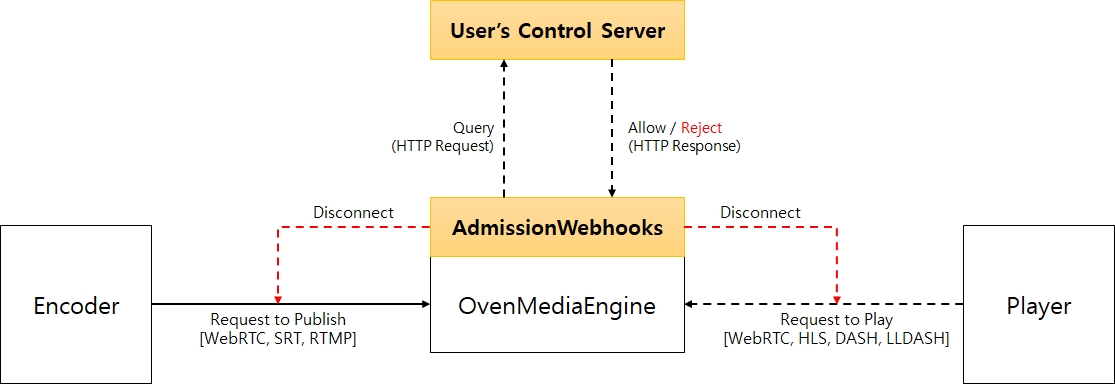AdmissionWebhooks
Overview
AdmissionWebhooks are HTTP callbacks that query the control server to control publishing and playback admission requests.

Users can use the AdmissionWebhook for a variety of purposes, including customer authentication, tracking published streams, hide app/stream names, logging and more.
Configuration
AdmissionWebhooks can be set up on VirtualHost, as shown below.
ControlServerUrl
The HTTP Server to receive the query. HTTP and HTTPS are available.
SecretKey
The secret key used when encrypting with HMAC-SHA1
For more information, see Security.
Timeout
Time to wait for a response after request (in milliseconds)
Enables
Enable Providers and Publishers to use AdmissionWebhooks
Request
Format
AdmissionWebhooks send HTTP/1.1 request message to the configured user's control server when an encoder requests publishing or a player requests playback. The request message format is as follows.
The message is sent in POST method and the payload is in application/json format. X-OME-Signature is a base64 url safe encoded value obtained by encrypting the payload with HMAC-SHA1 so that the ControlServer can validate this message. See the Security section for more information on X-OME-Signature.
Here is a detailed explanation of each element of Json payload:
client
Information of the client who requested the connection.
address
IP address of the client connected to the server
port
Port number of the client connected to the server
real_ip
IP address of the client forwarded by the proxy server
user_agent (optional)
Client's User_Agent
request
Information about the client's request
direction
incoming : A client requests to publish a stream
outgoing : A client requests to play a stream
protocol
webrtc, srt, rtmp, llhls, thumbnail
status
opening : A client requests to open a stream
closing : A client closed the stream
url
url requested by the client
new_url (optional)
url redirected from user's control server (status "closing" only)
time
time requested by the client (ISO8601 format)
OME searches for and sets the values in real_ip in the following order:
The value of the X-REAL-IP header
The value of the first item of X-FORWARDED-FOR
The IP of the client that is actually connected
Security
The control server may need to validate incoming http requests for security reasons. To do this, the AdmissionWebhooks module puts the X-OME-Signature value in the HTTP request header. X-OME-Signature is a base64 url safe encoded value obtained by encrypting the payload of an HTTP request with the HMAC-SHA1 algorithm using the secret key set in <AdmissionWebhooks><SecretKey> of the configuration.
Conditions that triggers the request
As shown below, the trigger condition of request is different for each protocol.
WebRTC
When a client requests Offer SDP
RTMP
When a client sends a publish message
SRT
When a client send a streamid
LLHLS
When a client requests a playlist (llhls.m3u8)
Response for closing status
The engine in the closing state does not need any parameter in response. To the query just answer with empty json object.
Response for opening status
Format
ControlServer must respond with the following Json format. In particular, the "allowed" element is required.
allowed (required)
true or false
Allows or rejects the client's request.
new_url (optional)
Redirects the client to a new url. However, the scheme, port, and file cannot be different from the request. Only host, app, and stream can be changed. The host can only be changed to another virtual host on the same server.
lifetime (optional)
The amount of time (in milliseconds) that a client can maintain a connection (Publishing or Playback)
0 means infinity
HTTP based streaming (HLS) does not keep a connection, so this value does not apply.
reason (optional)
If allowed is false, it will be output to the log.
User authentication and control
new_url redirects the original request to another app/stream. This can be used to hide the actual app/stream name from the user or to authenticate the user by inserting additional information instead of the app/stream name.
For example, you can issue a WebRTC streaming URL by inserting the user ID as follows: ws://domain.com:3333/user_id It will be more effective if you issue a URl with the encrypted value that contains the user ID, url expiration time, and other information.
After the Control Server checks whether the user is authorized to play using user_id, and responds with ws://domain.com:3333/app/sport-3 to new_url, the user can play app/sport-3.
If the user has only one hour of playback rights, the Control Server responds by putting 3600000 in the lifetime.
Was this helpful?